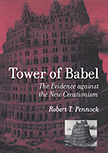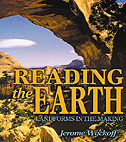
Rex Buchanan
| Geotimes Home | Calendar | Classifieds | Subscribe | Advertise |
| Geotimes
Published by the American Geological Institute |
Newsmagazine
of the Earth Sciences
July 2000 |
Book review
On the shelf
Where to order
 |
Tower
of Babel: The Evidence Against the New Creationism by Robert T. Pennock,
MIT Press. 1999. ISBN 0-262-16180-X. Hardback, $35, Paperback, $18.95.
429 p.
Rex Buchanan |
Probably no event in recent memory has revived the fight between creationism and evolution so much as the Kansas Board of Education’s decision to remove “macro-evolution” from the state’s science standards. For the most part, members of the Board argued that their decision was scientifically sound. The theory of evolution is so fraught with problems, they said, it should not be taught as fact.
The Board’s decision last August cast the national media spotlight on Kansas. Now scientists are beginning to understand the importance of following the decisions of state boards of education. Since then, we’ve all learned a great deal about evolution, creationism and arguments over the development of life. Not to mention politics.
For scientists unfamiliar with creationism and the context of this debate, Robert Pennock’s Tower of Babel: The Evidence Against the New Creationism is an in-depth discussion of these issues. Pennock explains exactly why evolution — an idea that the scientific community assumed was so widely accepted that it no longer needed public defending — is the focus of such controversy. To some fundamentalist religious groups, evolution represents directionless change in the universe. For them, a lack of direction implies that God does not exist.
Pennock describes in detail the variety of forms that creationism has taken, from young-Earth creationists (who believe that Earth is only a few thousands years old) to old-Earth creationists (who believe in the antiquity of Earth, but also believe in the biblical story of creation), to believers in intelligent design, a creative new approach to this issue (see Political Scene, p. 12). Pennock also carefully dissects many of the arguments that creationists use in their attack on evolution. In particular, he points out their tendency to reason from the negative. That is, creationists describe the problems that they perceive with the theory of evolution, then presume that we must automatically accept their alternative explanations, such as creationism or intelligent design, regardless of the problems with those theories.
Pennock is a philosopher of science, a useful background when it comes to teasing apart arguments and finding holes in concepts. Perhaps his most important point is that creationism is more than just an alternative idea. It is a deeply unscientific way of viewing the world, one that allows the invocation of non-natural explanations for natural events. Creationism stands in almost direct opposition to the methodology that has made science such a powerful means of understanding the world. This is a thorough, comprehensive book, one that examines these issues in great depth. For the most part, Pennock writes in a readable, first-person voice, rather than strictly academic language. At other times, however, the language and concepts of philosophy become dense and nearly overwhelming. Still, Pennock’s book is an excellent discussion of the creationist movement.
And this movement is not going away, in Kansas or in the rest of the country, any time soon. Creationists have made a case that seems to resonate with the public, effectively arguing that creationism simply be allowed equal time in the name of fairness; painting the scientific community as a band of intolerant elitists; and throwing up objection after objection to the concept of evolution. It is difficult to counter those objections without knowing the arguments that creationists make. Pennock has provided a detailed analysis of creationism’s claims and ideas, along with a critique of their reasoning.
If ever a book came along at a propitious time, this is the one.
Buchanan is an associate director of the Kansas Geological Survery.
 |
Reading
the Earth: Landforms in the Making by Jerome Wyckoff. Adastra West
Inc. 1999. 352 p. ISBN 0-9674075-0-8. Illus. Cloth, $29.95.
Ellen Wohl |
Jerome Wyckoff is the author of several very successful books on geology, including The Story of Geology and Rock, Time, and Landforms. Reading the Earth adds another excellent volume to the collection of books available to people who may have little or no formal training in geology but who are curious about the landscapes that surround them.
Its introduction describes Reading the Earth as a nonspecialist’s guide to landforms and one that focuses on specific kinds of landforms rather than on the complex systems that control landform evolution. From there, the reader gets an introduction to geology (timeframe, rock cycle, plate tectonics); petrology (rock types); and weathering — along with descriptions of the landscapes created by or associated with gravity movements, hillslopes, rivers, igneous activity, structures, mountains, plateaus, plains, glaciers, deserts, karst and coasts.
The book’s organization is slightly different than the organization geologists usually see in various geomorphology texts, but the structure is, nonetheless, appropriate and effective. Each chapter is a logical progression of ideas and information. The content of the chapter builds on that of other chapters, or each chapter can stand alone as a source of information on a particular type of landscape.
Reading the Earth is accessible to the geologist and non-geologist alike, combining rich illustrations with graceful writing. Technical explanations are balanced with poetic, evocative prose and appropriate metaphors and examples that should hold the reader’s interest. Wyckoff explains technical terms well enough that they should not provide barriers to a reader who is not a geologist. Populating the book are 556 photographs and 75 line drawings, all both beautiful and effective, illustrating landforms and landform processes from around the world. Above all, the author’s obvious appreciation for landscape will enhance the reader’s appreciation. It is accessible to readers interested in geology and landscapes, or to students in an introductory geomorphology or landforms course.
Reading the Earth is also useful as a reference; it has a good index with no errors or inaccuracies. The book’s format is attractive, and at $29.95, it is a bargain.
I have already recommended Reading the Earth to friends who are not
geologists but are interested in geology, and I recommend it to any Geotimes
reader who is fond of good photography and good prose.
Wohl
teaches in the Department of Earth Resources at Colorado State University
in Ft. Collins, Colo.
America’s Ancient Forests by Thomas M. Bonnicksen. John Wiley & Sons (2000). 608 p. ISBN 0-471-13622-0. Illus. Cloth, $49.95.
Active Tectonics and Alluvial Rivers by Stanley Schumm, Jean Dumont and John Holbrook. Cambridge University Press (2000). 276 p. ISBN 0-521-6110-2. Cloth, $80.
Building Planet Earth: Five Billion Years in Earth History by Peter Cattermole. Cambridge University Press (2000). 276 p. ISBN 0-521-58278-4. Illus. Cloth, $29.95.
The Earth Around Us: Maintaining a Livable Planet, edited by Jill Schneiderman. W.H. Freeman and Co. (2000). 455 p. ISBN 0-7167-3397-8. Illus. Cloth, $27.95.
The Effects of UV Radiation in the Marine Environment, edited by Stephen de Mora, Serge Demers and Maria Vernet. Cambridge University Press (2000). 324 p. ISBN 0-521-63218-8. Illus. Cloth, $80.
The Establishment of Science in America: 150 Years of the American Association for the Advancement of Science by Sally Gregory Kohlstedt, Michael Sokal and Bruce Lewenstein. Rutgers Unviersity Press (1999). 272 p. ISBN 0-8135-2705-8. Illus. Cloth, $35.
Glacial Processes: Past and Present, edited by David Mickelson and John Attig. Geological Society of America (1999). Special Paper Series SPE337. 216 p. ISBN 0-8137-2337-X. Illus. Paperback, $38.
Hydrogeology in Practice: A Guide to Characterizing Ground-Water Systems, by William J. Stone. Prentice Hall (1999). 336 p. ISBN 0-13-899154-5. Cloth, $33.33.
Measuring the Natural Environment by Ian Strangeways.
Cambridge University Press (2000). 365p. ISBN 0-521-57310-6. Illus. Cloth,
$74.95.
Also visit AGI's Earth
Science Bookstore to search Amazon.com.
Cambridge University Press, 110 Midland Ave., Port Chester, N.Y. 10573-4390. Phone: (800)872-7423. Fax: (914)937-4712. WWW: http://www.cup.org.
Geological Society of America, P.O. Box 9140, Boulder, Colo. 80301-9140. Phone: (800)472-1988. Fax: (303)447-1133. WWW: http://www.geosociety.org.
Prentice Hall, Simon and Schuster/A Viacom Company, P.O. Box 11071, Des Moines, Iowa 50336. Phone: (800)947-7700. WWW: http://www.prenhall.com.
Rutgers University Press, Bldg. 4161, Livingston Campus, New Brunswick, N.J. 08903-5062. Phone: (800)446-9323. Fax: (908)445-1974. E-mail: ccapps@rci.rutgers.edu.
John Wiley & Sons, Inc., Distribution
Center, 1 Wiley Drive, Somerset, N.J. 08875. Phone: (800)225-5945. Fax:
(732)302-2300. E-mail: bookinfo@wiley.com.